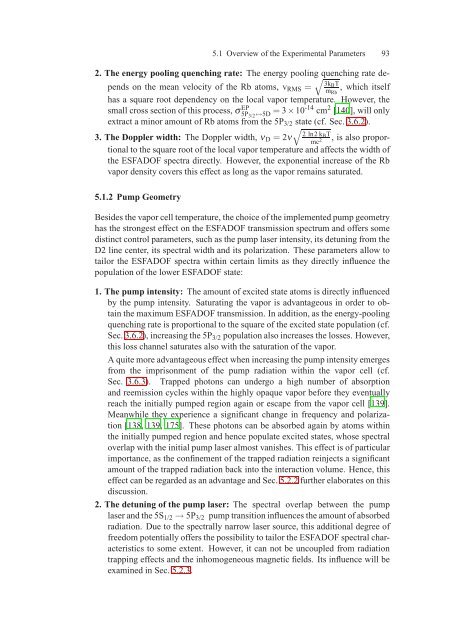Assessment of a Rubidium ESFADOF Edge-Filter as ... - tuprints
Assessment of a Rubidium ESFADOF Edge-Filter as ... - tuprints
Assessment of a Rubidium ESFADOF Edge-Filter as ... - tuprints
You also want an ePaper? Increase the reach of your titles
YUMPU automatically turns print PDFs into web optimized ePapers that Google loves.
5.1 Overview <strong>of</strong> the Experimental Parameters 93<br />
2. The energy pooling quenching rate: The energy pooling√ quenching rate depends<br />
on the mean velocity <strong>of</strong> the Rb atoms, v RMS = 3kB T<br />
m Rb<br />
, which itself<br />
h<strong>as</strong> a square root dependency on the local vapor temperature. However, the<br />
small cross section <strong>of</strong> this process, σ EP<br />
5P 3/2 ↔5D = 3×10-14 cm 2 [140], will only<br />
extract a minor amount <strong>of</strong> Rb atoms from the 5P 3/2 state (cf. Sec. 3.6.2).<br />
√<br />
2 ln2 kB T<br />
3. The Doppler width: The Doppler width, ν D = 2ν , is also proportional<br />
to the square root <strong>of</strong> the local vapor temperature and affects the width <strong>of</strong><br />
mc 2<br />
the <strong>ESFADOF</strong> spectra directly. However, the exponential incre<strong>as</strong>e <strong>of</strong> the Rb<br />
vapor density covers this effect <strong>as</strong> long <strong>as</strong> the vapor remains saturated.<br />
5.1.2 Pump Geometry<br />
Besides the vapor cell temperature, the choice <strong>of</strong> the implemented pump geometry<br />
h<strong>as</strong> the strongest effect on the <strong>ESFADOF</strong> transmission spectrum and <strong>of</strong>fers some<br />
distinct control parameters, such <strong>as</strong> the pump l<strong>as</strong>er intensity, its detuning from the<br />
D2 line center, its spectral width and its polarization. These parameters allow to<br />
tailor the <strong>ESFADOF</strong> spectra within certain limits <strong>as</strong> they directly influence the<br />
population <strong>of</strong> the lower <strong>ESFADOF</strong> state:<br />
1. The pump intensity: The amount <strong>of</strong> excited state atoms is directly influenced<br />
by the pump intensity. Saturating the vapor is advantageous in order to obtain<br />
the maximum <strong>ESFADOF</strong> transmission. In addition, <strong>as</strong> the energy-pooling<br />
quenching rate is proportional to the square <strong>of</strong> the excited state population (cf.<br />
Sec. 3.6.2), incre<strong>as</strong>ing the 5P 3/2 population also incre<strong>as</strong>es the losses. However,<br />
this loss channel saturates also with the saturation <strong>of</strong> the vapor.<br />
A quite more advantageous effect when incre<strong>as</strong>ing the pump intensity emerges<br />
from the imprisonment <strong>of</strong> the pump radiation within the vapor cell (cf.<br />
Sec. 3.6.3). Trapped photons can undergo a high number <strong>of</strong> absorption<br />
and reemission cycles within the highly opaque vapor before they eventually<br />
reach the initially pumped region again or escape from the vapor cell [139].<br />
Meanwhile they experience a significant change in frequency and polarization<br />
[138, 139, 175]. These photons can be absorbed again by atoms within<br />
the initially pumped region and hence populate excited states, whose spectral<br />
overlap with the initial pump l<strong>as</strong>er almost vanishes. This effect is <strong>of</strong> particular<br />
importance, <strong>as</strong> the confinement <strong>of</strong> the trapped radiation reinjects a significant<br />
amount <strong>of</strong> the trapped radiation back into the interaction volume. Hence, this<br />
effect can be regarded <strong>as</strong> an advantage and Sec. 5.2.2 further elaborates on this<br />
discussion.<br />
2. The detuning <strong>of</strong> the pump l<strong>as</strong>er: The spectral overlap between the pump<br />
l<strong>as</strong>er and the 5S 1/2 → 5P 3/2 pump transition influences the amount <strong>of</strong> absorbed<br />
radiation. Due to the spectrally narrow l<strong>as</strong>er source, this additional degree <strong>of</strong><br />
freedom potentially <strong>of</strong>fers the possibility to tailor the <strong>ESFADOF</strong> spectral characteristics<br />
to some extent. However, it can not be uncoupled from radiation<br />
trapping effects and the inhomogeneous magnetic fields. Its influence will be<br />
examined in Sec. 5.2.3.
















